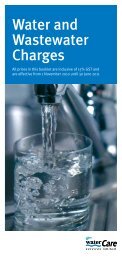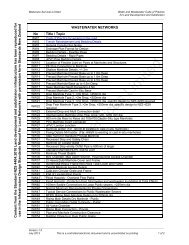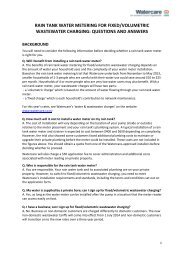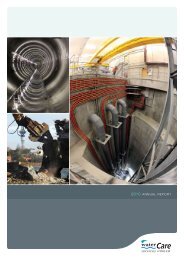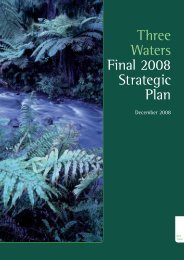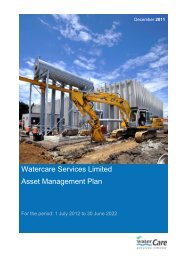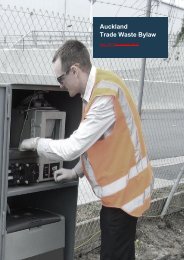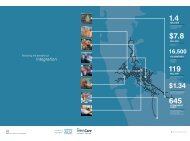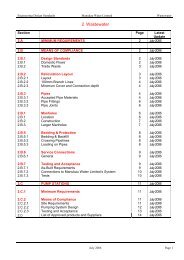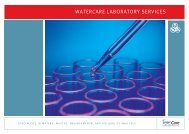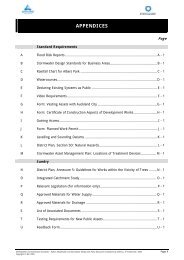Watercare Services Limited Asset Management Plan
Watercare Services Limited Asset Management Plan
Watercare Services Limited Asset Management Plan
You also want an ePaper? Increase the reach of your titles
YUMPU automatically turns print PDFs into web optimized ePapers that Google loves.
<strong>Watercare</strong> <strong>Services</strong> <strong>Limited</strong><br />
<strong>Asset</strong> <strong>Management</strong> <strong>Plan</strong><br />
For the period: 1 July 2011 to 30 June 2012
<strong>Watercare</strong> <strong>Services</strong> <strong>Limited</strong><br />
ASSET MANAGEMENT PLAN<br />
1 July 2011 to 30 June 2012<br />
<strong>Watercare</strong> <strong>Services</strong> <strong>Limited</strong><br />
<strong>Asset</strong> <strong>Management</strong> <strong>Plan</strong><br />
FOR THE FINANCIAL YEAR ENDING JUNE 2012<br />
Contents<br />
1.0 INTRODUCTION 3<br />
1.1 Business and Operating Environment 3<br />
1.2 Scope of Business Activities 3<br />
1.3 Strategic Direction 4<br />
1.4 Organisational Structure 4<br />
2.0 ASSET MANAGEMENT PLAN 7<br />
2.1 Business Drivers 7<br />
2.2 Cost Indexation 10<br />
3.0 TOTAL EXPENDITURE FORECAST FOR 2011/12 11<br />
3.1 Capital Expenditure Forecasts 11<br />
Appendix 1 Key Capital Projects 15<br />
TABLES<br />
Table 1 Total Forecast Expenditure for 2011/12 11<br />
Table 2 Capital Expenditure Forecast 12<br />
Page 1
<strong>Watercare</strong> <strong>Services</strong> <strong>Limited</strong><br />
ASSET MANAGEMENT PLAN<br />
1 July 2011 to 30 June 2012<br />
The North Shore No. 1 and No. 2 watermains, located under the carriageway of the Auckland Harbour Bridge, which supply drinking<br />
water to North Shore households and businesses, were recently lowered at the urgent request of the NZ Transport Agency to avoid the<br />
high risk of rupture due to the carriageway above flexing with traffic movement. The project required new pipes to be barged to the site<br />
and hoisted into position at the lower level so that the existing pipeline could continue to carry water to supply the North Shore.<br />
Page 2
<strong>Watercare</strong> <strong>Services</strong> <strong>Limited</strong><br />
ASSET MANAGEMENT PLAN<br />
1 July 2011 to 30 June 2012<br />
1.0 INTRODUCTION<br />
1.1 Business and Operating Environment<br />
<strong>Watercare</strong> <strong>Services</strong> <strong>Limited</strong> (<strong>Watercare</strong>) is the water and wastewater services company for the Auckland<br />
region. On 1 November 2010 responsibility for the water and wastewater assets and the provision of retail<br />
water and wastewater services in the former city or district councils of Rodney, North Shore, Waitakere,<br />
Auckland, Manukau, Papakura and Franklin was transferred to <strong>Watercare</strong>. In the Papakura area, United<br />
Water <strong>Limited</strong> manages the local networks and the retailing of water and wastewater services under a<br />
franchise agreement with <strong>Watercare</strong>.<br />
Notwithstanding the governance changes in the Auckland region, <strong>Watercare</strong> is still required to meet specific<br />
provisions of the Local Government Act 1974 and relevant amendments to the Local Government (Auckland<br />
Council) Act 2009. In particular, <strong>Watercare</strong> has an obligation to manage its operation efficiently with a view<br />
to keeping the overall costs to customers (collectively) at minimum levels whilst maintaining the long term<br />
integrity of its assets to ensure safe and reliable water supply and wastewater services; an obligation not to<br />
pay a dividend or distribute any surplus to its shareholder (the Auckland Council); and a requirement to have<br />
regard to public safety in relation to <strong>Watercare</strong>’s structures.<br />
1.2 Scope of Business Activities<br />
<strong>Watercare</strong>’s core business functions are:<br />
• The collection, treatment and distribution of drinking water for the people of Auckland<br />
• The collection, treatment and disposal of wastewater for the people of Auckland<br />
• The transfer, treatment and disposal of trade wastes<br />
• The provision of commercial laboratory services to support <strong>Watercare</strong>’s business and the business<br />
of external customers<br />
<strong>Watercare</strong> manages the provision of reticulated water and wastewater services for the Auckland region from<br />
the source to the sea. This includes ownership and management of:<br />
• The Metropolitan 1 water scheme which services around half a million properties via 9,000km of water<br />
pipes. Water is sourced from 9 dams (in service) in the Hunua and Waitakere Ranges, the Waikato<br />
River and a groundwater source in Onehunga and treated at 6 treatment plants.<br />
• 16 Non-metropolitan water supply schemes servicing around 30,000 properties.<br />
• The three main wastewater treatment plants at Rosedale, Mangere and Army Bay that process<br />
wastewater collected from around half a million properties via 7,000km of wastewater pipe.<br />
• 18 Non-metropolitan wastewater schemes servicing approximately 45,000 properties.<br />
• Laboratory services, one of the largest water, wastewater and environmental laboratories in New<br />
Zealand providing sampling, on-site monitoring, analytical and scientific services to a wide range of<br />
clients nationwide.<br />
1 In this plan the term Metropolitan refers to the contiguous water supply and wastewater networks servicing the<br />
urbanised areas of the North Shore, Waitakere, Auckland and Manukau and Non‐metropolitan refers to the separate<br />
schemes servicing stand alone communities in the region.<br />
Page 3
<strong>Watercare</strong> <strong>Services</strong> <strong>Limited</strong><br />
ASSET MANAGEMENT PLAN<br />
1 July 2011 to 30 June 2012<br />
• Control of trade waste in the Auckland region, including management of, and charging for, discharge<br />
consents to over 1700 trade waste customers that discharge to the wastewater collection network.<br />
1.3 Strategic Direction<br />
<strong>Watercare</strong>’s Vision:<br />
Outstanding and affordable water services for all the people Auckland.<br />
Not only will we deliver water and wastewater services which exceed industry benchmarks and customer<br />
service standards but we will do so at a cost which makes our services affordable for all. That is our<br />
challenge.<br />
Success in achieving our vision will come from our capability, our innovative approach to new challenges<br />
and placing the customer at the forefront of our decision making.<br />
<strong>Watercare</strong>’s strategic framework identifies 6 priorities:<br />
1. Satisfied Customers and Stakeholders: To provide great service and great value.<br />
2. Safe and Reliable Water Supply: To manage our water resources to provide a safe and reliable<br />
water supply.<br />
3. Healthy Waterways: To manage our wastewater discharges to maintain or improve the health of the<br />
environment.<br />
4. Sound Financial <strong>Management</strong>: To meet our business objectives at the lowest cost.<br />
5. Effective <strong>Asset</strong> <strong>Management</strong>: To maximise the use of existing assets while optimising the scope,<br />
timing and costs of new investments.<br />
6. Engaged People: To have a skilled, motivated and empowered workforce.<br />
1.4 Organisational Structure<br />
Figure 1 below shows how <strong>Watercare</strong> is organised to deliver the services to the people of Auckland.<br />
Office of the Chief Executive<br />
The Office of the Chief Executive is responsible for people, policy formulation, compliance and<br />
governance, and includes:<br />
• Corporate strategy and communications<br />
• Corporate relations<br />
• Human resources<br />
• Chief Engineer<br />
• Risk and Assurance<br />
• General Counsel<br />
Customer Business Unit<br />
The Customer business unit is responsible for managing and monitoring the delivery of customer<br />
services including meter reading, bill collection, the call centre and major accounts management.<br />
The business unit is split into 3 teams:<br />
Page 4
<strong>Watercare</strong> <strong>Services</strong> <strong>Limited</strong><br />
ASSET MANAGEMENT PLAN<br />
1 July 2011 to 30 June 2012<br />
• Customer <strong>Services</strong> – the first point of contact for all customer issues<br />
• Revenue – customer account management<br />
• Support and Strategy – providing support through reporting, training and market research<br />
Operations Business Unit<br />
The Operations business unit is responsible for water collection and treatment operations,<br />
wastewater treatment and network operations, maintenance planning, monitoring and prevention of<br />
wastewater overflows, risk management and laboratory services. The business unit is split into 6<br />
teams:<br />
• Wastewater team - oversees the collection, treatment and disposal of wastewater throughout the<br />
region<br />
• Network team – manages the elaborate network of pipes and reticulation plants that delivers<br />
fresh water to our homes and takes away our wastewater<br />
• Water supply team – have stewardship over the dams and the bulk transmission assets that<br />
provide our city with drinking water<br />
• Maintenance team – accountable for servicing and preventative maintenance of all operating<br />
facilities<br />
• Commercial team – supplies laboratory testing services and scientific expertise for <strong>Watercare</strong>’s<br />
water and wastewater operations and a growing number of external organisations<br />
Figure 1 - <strong>Watercare</strong>'s Organisation Structure<br />
Page 5
<strong>Watercare</strong> <strong>Services</strong> <strong>Limited</strong><br />
ASSET MANAGEMENT PLAN<br />
1 July 2011 to 30 June 2012<br />
Infrastructure Business Unit<br />
The Infrastructure business unit manages the planning, development and delivery of assets to the<br />
operations team to meet projected long-term business needs. The Infrastructure business unit is split<br />
into 5 teams:<br />
• Statutory planning team - responsible for environmental management services and ensuring<br />
that the business has the consents required by the Resource <strong>Management</strong> Act to conduct<br />
operations in an efficient and timely manner.<br />
• <strong>Asset</strong> planning team – responsible for development of detailed asset management plans, taking<br />
into account growth, legislative, agreed levels of service and renewal needs. Then to prioritise<br />
the associated capital investment programme to minimise risk and to deliver agreed levels of<br />
service with minimum lifecycle cost.<br />
• Projects team - development and delivery of capital projects on-time and to budget whilst<br />
meeting quality parameters.<br />
• Energy and control systems - planning and delivering energy and control systems.<br />
• New developments - managing business with real estate developers, asset information,<br />
geographic information systems, engineering records and issue of permits to third parties.<br />
Finance Business Unit<br />
The Finance business unit provides a range of support services to the business as follows:<br />
• Accounting - undertakes all financial transactions, financial reporting, treasury functions and<br />
credit management<br />
• Treasury - manages the company’s borrowings requirements and interest rates<br />
• Information services - strategic planning and technical direction for the application of existing and<br />
emerging technologies, computing and networking facilities, data organisation, custodianship<br />
and access to facilities as well as software development, selection and integration services<br />
• Procurement - purchase of goods and services, supplier contracts, spare parts and consumables<br />
• Property - providing land and property management services to the company<br />
Page 6
<strong>Watercare</strong> <strong>Services</strong> <strong>Limited</strong><br />
ASSET MANAGEMENT PLAN<br />
1 July 2011 to 30 June 2012<br />
2.0 ASSET MANAGEMENT PLAN<br />
The <strong>Asset</strong> <strong>Management</strong> <strong>Plan</strong> (AMP) is <strong>Watercare</strong>’s tactical plan for managing the company’s infrastructure<br />
cost-effectively to achieve long-term goals. The AMP presents an integrated programme of works linking<br />
capital investment with changes in maintenance and operational expenditure.<br />
Section 18 (e) of the Local Government (Auckland Transitional Provisions) Act 2010 states that until the end<br />
of 30 June 2012, <strong>Watercare</strong> <strong>Services</strong> <strong>Limited</strong>:<br />
“Must, at least 4 months before the end of each financial year, prepare and<br />
supply to the Auckland Council an indicative asset management plan for the<br />
next financial year that must describe the projected condition of its significant<br />
assets at the commencement of that year and outline the rationale for and<br />
nature, extent, and estimated costs of its proposed activities in respect of:<br />
• the maintenance and repair of existing asset; and<br />
• the renewal of existing assets; and<br />
• the upgrading or extension of the performance or capacity of existing<br />
assets; and<br />
• the acquisition and construction of new assets”<br />
<strong>Watercare</strong> reviews and refines the AMP every year, taking into account any changes to business drivers,<br />
improved information and feedback from stakeholders. Historically, <strong>Watercare</strong> published an AMP covering a<br />
20-year period. In 2009, <strong>Watercare</strong> made a departure from the publication of a 20-year AMP because the<br />
integration of the Auckland water industry which will require the preparation of a new regional plan. In order<br />
to satisfy Section 707ZZZS1 (k) of the Local Government Act 1974, <strong>Watercare</strong> published an indicative AMP<br />
for the single financial year ending June 2011.<br />
This year, although the integration process is now complete, the regional priorities and the condition of the<br />
transferred assets are yet to be fully understood by the newly integrated company. As a consequence, this<br />
AMP is again being published as a one-year plan focusing on the financial forecasts for the year ending 30<br />
June 2012.<br />
2.1 Business Drivers<br />
The levels of service provided by <strong>Watercare</strong> are defined by:<br />
• Regulatory standards<br />
• Customer contracts<br />
• The Statement of Corporate Intent<br />
• Health and safety legislation<br />
• Sustainability targets<br />
These business drivers are the foundation of the plan and the basis for determining whether existing assets<br />
need to be upgraded or replaced and whether new assets need to be constructed.<br />
Capital expenditure investments are motivated by three key drivers – growth, renewal and service-level<br />
improvement.<br />
Page 7
<strong>Watercare</strong> <strong>Services</strong> <strong>Limited</strong><br />
ASSET MANAGEMENT PLAN<br />
1 July 2011 to 30 June 2012<br />
Growth:<br />
Renewal:<br />
A key issue facing <strong>Watercare</strong> is the growth of the Auckland region. This will result in increasing<br />
demand for water supply and wastewater services. Efficient use of the existing infrastructure<br />
through demand management and inflow and infiltration control initiatives, as well as the<br />
enhancement and expansion of infrastructure, will be required to service this increasing<br />
demand.<br />
<strong>Watercare</strong> has an ongoing programme to assess the condition and performance of its<br />
reticulation and treatment assets. Prudent provisions are made for their necessary renewal<br />
given the company’s detailed knowledge of the age and condition of the infrastructure.<br />
Service-level improvement:<br />
There are a range of factors, in addition to growth and renewal, which necessitates the need to<br />
upgrade or replace assets or to provide additional new assets. These include:<br />
• Regulatory compliance: meeting the requirements of health and safety legislation, the<br />
Building Act, drinking water guidelines and conditions of consents granted under the<br />
Resource <strong>Management</strong> Act<br />
• Risk mitigation: investments to reduce the likelihood or consequence of an asset failure<br />
• Security of supply: provisions to ensure alternative pathways and storage are available in<br />
the event of an emergency and to facilitate maintenance activities without adverse effects on<br />
levels of service<br />
• Levels of service: investments required to meet changes to levels of service agreed with the<br />
customers or to provide operational flexibility and additional operational headroom<br />
• Business improvement: enhancements which reduce ongoing operational costs and improve<br />
business processes or organisational efficiency<br />
The Manukau Harbour Crossing<br />
section of the Hunua No. 4 Water<br />
Supply Scheme project.<br />
The Hunua No. 4 project involves the<br />
construction of approximately 35km of<br />
new trunk watermain between<br />
<strong>Watercare</strong>’s Redoubt North Reservoir<br />
Complex and the Khyber Pass<br />
Reservoirs in central Auckland. The<br />
project will increase capacity of the<br />
network to meet the increasing<br />
demand for water driven by population<br />
growth and will also provide security of<br />
supply in the event of failure of the<br />
existing Hunua No. 3 pipeline and<br />
enable the existing pipeline to be<br />
taken out of service for maintenance<br />
without compromising water supply to<br />
households and industry. The<br />
construction of this section of pipeline<br />
has been undertaken in conjunction with the construction of the Manukau Harbour Crossing itself to take advantage of the economies<br />
of a joint project.<br />
Page 8
<strong>Watercare</strong> <strong>Services</strong> <strong>Limited</strong><br />
ASSET MANAGEMENT PLAN<br />
1 July 2011 to 30 June 2012<br />
Capital Expenditure Evaluation and Prioritisation<br />
A combination of formal prioritisation processes and engineering judgement, combined with a longestablished<br />
CAPEX evaluation process, are used to ensure that the optimal solution is considered for each<br />
investment and that available funds are targeted in areas that will provide most benefit. Development of a<br />
regional CAPEX evaluation and prioritisation approach is underway.<br />
<strong>Watercare</strong> has determined a relative weighting for each project objective, Figure 2. The weighting can<br />
change as a result of changes in business strategy and / or customers’ service expectations. This weighting<br />
is one part of the capital project prioritisation process and gives the reader an appreciation for the<br />
importance that <strong>Watercare</strong> places on different aspects of service delivery. Until a regional approach to<br />
capital project evaluation and prioritisation has been developed, the project objective weighting along with<br />
engineering judgement as to the risk that <strong>Watercare</strong> would otherwise be exposed to, is used as a guide for<br />
project prioritisation.<br />
Figure 2 - Project Objective Ranking<br />
Project Objective<br />
Water standards and regulatory compliance<br />
Wastewater standards and regulatory compliance<br />
Water emergency renewals<br />
Wastewater emergency renewals<br />
Water planned renewals<br />
Wastewater planned renewals<br />
Wastewater operational efficiency<br />
Water operational efficiency<br />
Wastewater growth in existing service areas<br />
Water growth in existing service areas<br />
Water improved level of service<br />
Wastewater growth in new service areas<br />
Wastewater improved level of service<br />
Water growth in new service areas<br />
Low<br />
Relative Importance<br />
High<br />
The top six objectives have the need to maintain existing levels of service as their primary driver.<br />
Page 9
<strong>Watercare</strong> <strong>Services</strong> <strong>Limited</strong><br />
ASSET MANAGEMENT PLAN<br />
1 July 2011 to 30 June 2012<br />
<strong>Watercare</strong> is often required to relocate<br />
watermains or sewers in response to major<br />
road construction such as the Victoria Park<br />
Tunnel project. The project has required the<br />
realignment of pipes along Jervois Road<br />
using new 810mm diameter, concrete lined<br />
steel pipes so that service can be<br />
maintained through the existing pipes.<br />
2.2 Cost Indexation<br />
The purpose of cost indexation is to bring project estimates established the previous year to current day<br />
dollars.<br />
The cost estimate for projects in the capital expenditure programme have been aligned with the unit-rate<br />
costs model which were independently reviewed and updated by AECOM to June 2010.<br />
Specific unit-rate indexation has been used for water supply pipelines, water supply reservoirs, water supply<br />
pumping stations, wastewater pipelines, wastewater pipeline rehabilitation, wastewater pumping stations<br />
and wastewater storage tanks. The unit-rate cost models have generally changed very little over the past<br />
year.<br />
Where a unit-rate cost model is not available, an indexation of either a CGPI movement of 0% or a CPI<br />
movement of 2% (based on the movement in the period June 2009 to June 2010) has been used, depending<br />
on the type of project.<br />
To bring the estimates to 2011/12 dollars an additional factor of 3.276% has been applied.<br />
Page 10
<strong>Watercare</strong> <strong>Services</strong> <strong>Limited</strong><br />
ASSET MANAGEMENT PLAN<br />
1 July 2011 to 30 June 2012<br />
3.0 ASSET MANAGEMENT EXPENDITURE FORECASTS FOR<br />
2011/2012<br />
This AMP forecasts a total asset management expenditure (maintenance and capital) of $307.74 million for<br />
the financial year ending June 2012 (in 2011/12 dollars). Table 1 is a summary of the maintenance and<br />
capital expenditure forecast for 2011/12 by business category.<br />
The expenditure forecasts exclude the expenditure associated with the Commercial <strong>Services</strong> (Laboratory)<br />
function, interest and depreciation.<br />
Table 1 –Forecast <strong>Asset</strong> <strong>Management</strong> Expenditure for 2011/12<br />
Forecasts are stated in 2011/12 dollars ($ millions)<br />
Expenditure Type Business Area 2012<br />
Maintenance<br />
Capital<br />
ALL<br />
Water 27.81<br />
Wastewater 27.44<br />
Total 55.25<br />
Water 107.18<br />
Wastewater 126.61<br />
Shared <strong>Services</strong> 18.70<br />
Total 252.49<br />
Water 134.99<br />
Wastewater 154.05<br />
Shared <strong>Services</strong> 18.70<br />
Total 307.74<br />
These AMP forecasts are generally consistent with the provisional cost estimates prepared by <strong>Watercare</strong> in<br />
mid-2010 and provided to the Auckland Transition Agency for inclusion in the Auckland Council’s inaugural<br />
Long-Term <strong>Plan</strong> (1 November 2010-30 June 2019).<br />
3.1 Capital Expenditure Forecasts<br />
Table 2 shows the capital expenditure forecast for the year ending June 2012. The total capital expenditure<br />
forecast for 2012 is $252.49 million (in 2011/12 dollars). Growth related investment of approximately $116.6<br />
million is driven by a few large projects. For water, the Waikato Water Treatment <strong>Plan</strong>t expansion and the<br />
Hunua No. 4 Water Supply Scheme and for wastewater, the South Western Interceptor extension, Northern<br />
Waitakere Servicing, the Concourse storage tank and Takanini Area Servicing.<br />
Page 11
<strong>Watercare</strong> <strong>Services</strong> <strong>Limited</strong><br />
ASSET MANAGEMENT PLAN<br />
1 July 2011 to 30 June 2012<br />
Table 2 - Capital Expenditure Forecast<br />
Forecasts are stated in 2011/12 dollars ($ millions)<br />
Business Area<br />
Water<br />
Wastewater<br />
Shared<br />
<strong>Services</strong><br />
AMP Programme<br />
Capital Investment Driver<br />
Year<br />
Ending<br />
June 2012 Growth Renewal<br />
Improve<br />
Service<br />
Levels<br />
A100 Raw Water Network Rehab/Replacement 1.16 0.00 1.16 0.00<br />
A200 Raw Water Network Improvement 0.00 0.00 0.00 0.00<br />
C100 Water Shared ECS Rehab/Replacement 0.37 0.00 0.37 0.00<br />
C200 Water Shared ECS Improvement 0.52 0.00 0.00 0.52<br />
C300 Water Shared ECS Expansion 0.16 0.16 0.00 0.00<br />
D100 Dam Rehabilitation 2.44 0.00 1.51 0.93<br />
D200 Water Sources Improvement 0.00 0.00 0.00 0.00<br />
D300 Source Expansion 0.00 0.00 0.00 0.00<br />
D400 Regulatory Compliance 0.00 0.00 0.00 0.00<br />
F100 Water Treatment <strong>Plan</strong>t Rehab/Replacement 10.01 0.00 9.26 0.74<br />
F200 Water Treatment <strong>Plan</strong>t Improvement 12.53 0.00 5.12 7.41<br />
F300 Water Treatment <strong>Plan</strong>t Expansion 31.54 31.54 0.00 0.00<br />
F400 Water Treatment <strong>Plan</strong>t Regulatory Compliance 0.00 0.00 0.00 0.00<br />
W100 Treated Water Network Rehab/Replacement 14.43 0.20 12.31 1.93<br />
W200 Treated Water Network Improvement 1.40 0.14 0.22 1.05<br />
W300 Treated Water Network Expansion 9.09 6.06 1.44 1.59<br />
W500 Hunua No. 4 Water Supply Scheme 23.11 15.49 0.00 7.63<br />
W600 CBD Storage 0.00 0.00 0.00 0.00<br />
X000 Water Demolition 0.41 0.00 0.00 0.41<br />
Total Water Programmes 107.18 53.58 31.39 22.22<br />
E100 Energy & Control Systems Rehab & Replacement 0.67 0.00 0.67 0.00<br />
E200 Energy & Control Systems Improvement 0.96 0.00 0.00 0.96<br />
E300 Energy & Control Systems Expansion 0.29 0.29 0.00 0.00<br />
N100 Collection System Replacement 25.24 0.09 25.07 0.09<br />
N200 Collection System Improvement 8.54 2.05 0.53 5.96<br />
N300 Collection System Expansion 66.99 54.54 4.60 7.85<br />
N400 Wastewater Network Regulatory Compliance 0.52 0.00 0.00 0.52<br />
N500 Project Hobson 0.00 0.00 0.00 0.00<br />
N600 Central Interceptor 3.31 0.80 0.00 2.52<br />
Q100 Trade Waste 0.29 0.00 0.00 0.29<br />
T100 Wastewater Treatment Rehab/Replacement 6.08 0.05 6.03 0.00<br />
T200 Wastewater Treatment Improvement 8.03 0.76 2.77 4.50<br />
T300 Wastewater Treatment Expansion 4.97 4.40 0.32 0.24<br />
T400 WWTP Regulatory Compliance 0.36 0.00 0.36 0.00<br />
Z000 Wastewater Demolition 0.36 0.00 0.00 0.36<br />
Total Wastewater Programmes 126.61 62.97 40.35 23.28<br />
B100 Shared <strong>Services</strong> <strong>Plan</strong>t & Equip Replacement 5.13 0.00 2.07 3.05<br />
B200 Shared <strong>Services</strong> Process Improvement 13.51 0.00 0.00 13.51<br />
B300 Shared <strong>Services</strong> Process Expansion 0.06 0.06 0.00 0.00<br />
Total Shared <strong>Services</strong> Programmes 18.70 0.06 2.07 16.56<br />
<strong>Watercare</strong> Consolidated 252.49 116.62 73.82 62.06<br />
Page 12
<strong>Watercare</strong> <strong>Services</strong> <strong>Limited</strong><br />
ASSET MANAGEMENT PLAN<br />
1 July 2011 to 30 June 2012<br />
Details on capital projects with a forecast expenditure of more than $1.0 million in 2012 are contained in<br />
Appendix 1 – Key Capital Projects.<br />
The capital expenditure forecasts within the <strong>Asset</strong> <strong>Management</strong> <strong>Plan</strong> are <strong>Watercare</strong>’s best estimate of the<br />
out-turn costs to plan, consent, design, construct and commission infrastructure projects. For each project,<br />
the forecasts are expressed as a series of annual expenditures indicating when a project is anticipated to<br />
start and finish.<br />
The degree of precision of these annual expenditure forecasts varies depending on the stage of the project’s<br />
development lifecycle.<br />
For example, the level of certainty around a project’s scope generally increases as the project moves from<br />
concept definition through to detailed design and into the delivery phase. Similarly, the timeframes<br />
associated with the delivery of a project become more certain as the detail associated with the project<br />
becomes more certain.<br />
Accordingly, projects which have commenced the delivery stage have much greater certainty around outturn<br />
costs and timing compared to projects which are at the concept definition stage. However, projects at<br />
the construction phase still face uncertainty. Factors beyond the control of <strong>Watercare</strong> or the construction<br />
contractor, such as unforeseen ground conditions or exceptionally adverse weather conditions, can result in<br />
additional costs or delays to the planned completion date.<br />
In order to ensure that the capital expenditure forecasts are realistic estimates of a project’s out-turn cost, a<br />
risk provision is built into each capital expenditure forecast to reflect the level of certainty associated with the<br />
project. Whilst this is considered to be an appropriate approach at a project specific level, it can lead to an<br />
over estimation of the actual level of capital expenditure at an aggregated level as it is unlikely that all<br />
projects will fully utilise their risk provisions.<br />
A review of the actual levels of capital expenditure investment versus <strong>Asset</strong> <strong>Management</strong> <strong>Plan</strong> forecasts has<br />
shown that on average <strong>Watercare</strong> typically achieves 85% to 90% of the forecast capital expenditure in any<br />
given year.<br />
The two primary drivers for this are considered to be programme delays resulting in capital expenditure<br />
being incurred later than forecast and the over-provisioning for risk across the programme as a whole.<br />
Recognising the importance of the <strong>Asset</strong> <strong>Management</strong> <strong>Plan</strong> forecasts in determining <strong>Watercare</strong>’s funding<br />
requirements and the over-estimation inherent in the planning process, a 10% reduction in the capital<br />
expenditure forecasts for the 2012 financial year for both the Water and Wastewater programmes will be<br />
included in the Funding <strong>Plan</strong>.<br />
Page 13
<strong>Watercare</strong> <strong>Services</strong> <strong>Limited</strong><br />
ASSET MANAGEMENT PLAN<br />
1 July 2011 to 30 June 2012<br />
The installation of a 3.2m diameter caisson (surge chamber) at the southern end of Manukau Harbour Crossing section of the Hunua<br />
No. 4 Water Supply Scheme project. This is the largest of its type in New Zealand. The caisson houses a submerged discharge valve<br />
capable of discharging up to 4.5cumecs of water during planned maintenance or a programmed or emergency flushing event. It is sized<br />
to provide flushing capability for the entire length of the Hunua No. 4 watermain and will be operated on a regular basis to mobilise and<br />
discharge pipeline sediments to reduce the risk of discoloured water occurrences.<br />
Page 14
<strong>Watercare</strong> <strong>Services</strong> <strong>Limited</strong><br />
ASSET MANAGEMENT PLAN<br />
1 July 2011 to 30 June 2012<br />
APPENDIX 1 – Key Capital Projects<br />
2011 Estimate and Budget are in 2010/11 dollars.<br />
2012 and subsequent estimates are stated in 2011/12 dollars ($ millions)<br />
Key<br />
Operational Area<br />
Water Treatment<br />
Water Networks<br />
Wastewater Networks<br />
Wastewater Treatment<br />
Shared <strong>Services</strong><br />
Capital projects with expenditure in 2012 greater than $1 million<br />
Operational<br />
Area<br />
Project Name<br />
AMP<br />
Programme<br />
Code<br />
2011<br />
Budget<br />
($ millions)<br />
2012<br />
Proposed<br />
Budget<br />
($ millions)<br />
Project<br />
Timing<br />
2012 to 2031<br />
Estimate<br />
($ millions)<br />
Water<br />
Treatment<br />
Ardmore - rapid restart,<br />
sludge lagoon and landfill<br />
F100 2.63 8.26<br />
2011 to<br />
2013<br />
17.56<br />
What the work involves:<br />
This project involves civil works to increase the capacity of the monofill<br />
facility, the replacement of the current sludge holding tank with a larger one,<br />
the excavation of Lagoon No.1 to increase its volume, and the construction<br />
of a sludge spill and contaminated waters catchment area adjacent to<br />
Lagoon No.1. The existing overflow and bypass infrastructure will be<br />
modified to suit the improved catchment and storage facilities.<br />
These works form the basis of a long-term by-products disposal strategy for<br />
the Ardmore site. Operational costs are minimised by the retention and<br />
treatment of off-specification waters and dewatered sludge on-site and by<br />
improving existing facilities.<br />
In addition, an upgrade to the sludge dewatering facilities will also take<br />
place, including an upgrade to or replacement of the existing presses and<br />
the installation of additional presses combined with an upgrade to the<br />
thickening process. The main sludge processing plant items are to be<br />
retained but process control is to be improved by upgrading instrumentation<br />
and direct control systems monitoring, and by replacing fixed-speed pumps<br />
with variable speed-control units. Water quality at each stage of the<br />
treatment process will be better managed, reducing the risk of noncompliant<br />
water returning to the head of the plant.<br />
In addition, improvements are to be made to the polyelectrolyte dosing<br />
system to improve dosing control and redundancy.<br />
Page 15
<strong>Watercare</strong> <strong>Services</strong> <strong>Limited</strong><br />
ASSET MANAGEMENT PLAN<br />
1 July 2011 to 30 June 2012<br />
Capital projects with expenditure in 2012 greater than $1 million<br />
Operational<br />
Area<br />
Project Name<br />
AMP<br />
Programme<br />
Code<br />
2011<br />
Budget<br />
($ millions)<br />
2012<br />
Proposed<br />
Budget<br />
($ millions)<br />
Project<br />
Timing<br />
2012 to 2031<br />
Estimate<br />
($ millions)<br />
Why the work needs to be<br />
done:<br />
The by-products produced as part of the water treatment process include<br />
off-specification drinking water arising from any stage of the treatment<br />
process, the solids (sludge) removed from the drinking water and waste<br />
products from the treatment process and sludge filter presses.<br />
The absence of a rapid restart facility to restore the water treatment process<br />
in the event of a process upset at Ardmore presents a significant risk to the<br />
continuity of water supply to the region. Also the current maximum<br />
consented discharge flow rate from the lagoons is considerably less than<br />
the plant’s maximum flow rate and does not specifically allow for process<br />
overflows or for the discharge of off-specification water into the<br />
environment. This is combined with the expansion of the existing on-site<br />
monofill which provides the least whole-of-life-cost for sludge disposal.<br />
At the Ardmore plant, sludge is collected from the clarification and filter upwash<br />
stages of the water treatment process. The collected sludge is<br />
thickened by assisted settlement, dewatered mechanically and finally<br />
disposed of to the on-site monofill. At present, the sludge thickening system<br />
performs poorly, delivering inconsistent sludge quality to the dewatering<br />
system. As a result<br />
the sludge treatment stream is labour intensive to operate, requiring manual<br />
sampling and monitoring of the thickening systems, and sludge throughput<br />
is reduced without warning.<br />
Water<br />
Treatment<br />
Ardmore chemical system<br />
upgrade<br />
F200 2.70 3.30<br />
2011 to<br />
2012<br />
3.30<br />
What the work involves:<br />
Construction of a disinfection system utilising chlorine gas with dual chlorine<br />
gas storage facilities, gas chlorination, dosing pumps and control systems<br />
to provide full redundancy<br />
Why the work needs to be<br />
done:<br />
Disinfection facilities are critical for the provision of safe drinking water and<br />
ensuring compliance with the DWSNZ 2005 (revised 2008). The existing<br />
sodium hypochlorite generator at Ardmore has failed and can no longer be<br />
economically repaired. A temporary disinfection system has been<br />
established but the operation of the plant remains vulnerable to this<br />
temporary system failing or to chemical supply chain interruptions. A<br />
permanent replacement disinfection system is therefore required.<br />
Water<br />
Treatment<br />
Ardmore ancillary services<br />
upgrade<br />
F200 0.21 1.47<br />
2012 to<br />
2013<br />
1.96<br />
What the work involves:<br />
A full upgrade of both the service air and service water systems to comply<br />
with current standards and to meet both current and future demand on both<br />
these systems in a reliable manner.<br />
Page 16
<strong>Watercare</strong> <strong>Services</strong> <strong>Limited</strong><br />
ASSET MANAGEMENT PLAN<br />
1 July 2011 to 30 June 2012<br />
Capital projects with expenditure in 2012 greater than $1 million<br />
Operational<br />
Area<br />
Project Name<br />
AMP<br />
Programme<br />
Code<br />
2011<br />
Budget<br />
($ millions)<br />
2012<br />
Proposed<br />
Budget<br />
($ millions)<br />
Project<br />
Timing<br />
2012 to 2031<br />
Estimate<br />
($ millions)<br />
Why the work needs to be<br />
done:<br />
The Ardmore Water Treatment <strong>Plan</strong>t currently has a pressurised service<br />
water system and a compressed air system for a variety of uses around the<br />
site. The service water system was originally intended to have two circuits –<br />
high and low pressure – and was last upgraded around 1980. Various adhoc<br />
piping amendments have been made to account for the abandonment<br />
of the high pressure system, leading to poor service and confusion as to<br />
how the system is to be operated. This system supports processes such as<br />
chemical make-up and systems flushing.<br />
The service air system was recently upgraded with new compressors but<br />
the piping systems remain at risk of failure due to corrosion and ad hoc<br />
modifications. This system supports the operation of equipment such as airactuated<br />
valves.<br />
Water<br />
Treatment<br />
Huia Sludge System F200 0.10 3.10<br />
2012 to<br />
2014<br />
22.72<br />
What the work involves:<br />
The main sludge processing plant is to be replaced as part of the long term<br />
upgrade planned for Huia, and in addition process control will be improved<br />
by upgrading instrumentation and direct control systems monitoring, and by<br />
replacing fixed-speed pumps with variable speed-control units. Water<br />
quality at each stage of the treatment process will be better managed,<br />
reducing the risk of non-compliant water returning to the head of the plant.<br />
In addition, improvements are to be made to the polyelectrolyte dosing<br />
system to improve dosing control and redundancy.<br />
Why the work needs to be<br />
done:<br />
At the Huia plant, sludge is collected from the clarification and filter up-wash<br />
stages of the water treatment process. The collected sludge is thickened by<br />
assisted settlement, dewatered mechanically and finally disposed of to the<br />
on-site monofill. At present, the sludge thickening system performs poorly,<br />
delivering inconsistent sludge quality to the dewatering system. As a result<br />
the sludge treatment stream is labour intensive to operate, requiring manual<br />
sampling and monitoring of the thickening systems, and sludge throughput<br />
is reduced without warning. The issues experienced at Huia are currently<br />
restricting plant production capacity for all but short periods, particularly<br />
when PAC is being dosed.<br />
Water<br />
Treatment<br />
Waikato - Stage 2a<br />
Expansion<br />
F300 8.20 31.54<br />
2011 to<br />
2013<br />
38.09<br />
What the work involves:<br />
This project is the next stage of the expansion as identified during the<br />
original plant design and construction. The works include expanding the<br />
treated water capacity to 125 MLD and the civil infrastructure to 150 MLD.<br />
The works, which will include additional process structures, mechanical<br />
equipment for the storage and dosing of chemicals and transfer of water<br />
and the associated electrical and controls equipment, will be built on the<br />
same site where space was allowed for.<br />
Page 17
<strong>Watercare</strong> <strong>Services</strong> <strong>Limited</strong><br />
ASSET MANAGEMENT PLAN<br />
1 July 2011 to 30 June 2012<br />
Capital projects with expenditure in 2012 greater than $1 million<br />
Operational<br />
Area<br />
Project Name<br />
AMP<br />
Programme<br />
Code<br />
2011<br />
Budget<br />
($ millions)<br />
2012<br />
Proposed<br />
Budget<br />
($ millions)<br />
Project<br />
Timing<br />
2012 to 2031<br />
Estimate<br />
($ millions)<br />
Why the work needs to be<br />
done:<br />
The WTP, commissioned in 2002, was designed to be constructed in<br />
stages with infrastructure being provided for varying capacities. The current<br />
capacity of the plant is 100 MLD. The expansion is required to ensure that<br />
<strong>Watercare</strong> may continue its level of service without applying water<br />
restrictions and will provide the same level of drought standard and<br />
redundancy requirements as was originally needed.<br />
Water<br />
Treatment<br />
UV Treatment - non-secure<br />
sources<br />
F200 0.00 1.03 2012 to 216 5.16<br />
What the work involves:<br />
This budget allows for small scheme, low complexity upgrades at the water<br />
treatment plants.<br />
Why the work needs to be<br />
done:<br />
These works will improve the operational efficiency of the water treatment<br />
plants ensuring that equipment failure does not pose unacceptable risk to<br />
service delivery.<br />
Water<br />
Networks<br />
Mt Eden Reservoirs<br />
Complex<br />
W100 6.16 2.07<br />
2011 to<br />
2012<br />
4.17<br />
What the work involves:<br />
The Mt Eden (No. 1, 2 and 3) reservoirs are all in poor condition, and<br />
require rehabilitation to minimise the risks arising from ongoing progressive<br />
deterioration. All three reservoirs are to be demolished and reconstructed<br />
in a staged programme, with a reservoir to remain in service at all times,<br />
and all works to be complete by August 2011. The deadline is to enable<br />
access to be restored before the 2011 Rugby World Cup<br />
In order to maintain water supply to the Maungawhau pressure zone during<br />
the proposed Mt Eden reservoir reconstruction works, enabling works will<br />
be required at the Khyber and Campbell pump stations. These include<br />
installation of pressure sustaining valves, and construction of a bypass at<br />
Mt Eden reservoirs.<br />
Page 18
<strong>Watercare</strong> <strong>Services</strong> <strong>Limited</strong><br />
ASSET MANAGEMENT PLAN<br />
1 July 2011 to 30 June 2012<br />
Capital projects with expenditure in 2012 greater than $1 million<br />
Operational<br />
Area<br />
Project Name<br />
AMP<br />
Programme<br />
Code<br />
2011<br />
Budget<br />
($ millions)<br />
2012<br />
Proposed<br />
Budget<br />
($ millions)<br />
Project<br />
Timing<br />
2012 to 2031<br />
Estimate<br />
($ millions)<br />
Why the work needs to be<br />
done:<br />
The Maungawhau pressure zone comprises the Mt Eden, Epsom and<br />
Greenlane areas of Auckland City. The requirement for storage under the<br />
“Public Heath Grading of Community Drinking water Supplies 2003”, as<br />
published by the Ministry of Health, Part 3: Grading of distribution, there is a<br />
recommendation that at least 24 hours storage be available assuming<br />
average daily demand in a covered secured service reservoir. Should less<br />
than 24 hours storage be available then the zone will be subject to 3<br />
demerit points. These demerit points could impact on the network grading<br />
and proposed grading zones.<br />
The current average day demand of approximately 17,000 m3/day is<br />
significantly more than the daily storage currently available for the zone.<br />
The restricted available storage places greater reliance on the Khyber and<br />
Campbell Pump Stations which supply the Mt Eden reservoirs. In the event<br />
of a loss of power to these pump stations there would be insufficient supply<br />
to the Maungawhau pressure zone to meet demand, and therefore a<br />
significant risk to security of supply.<br />
Following rehabilitation of all three Mt Eden reservoirs there will be<br />
sufficient storage volume to meet the projected growth requirements for the<br />
Maungawhau pressure zone through to 2061 (22,000 m3).<br />
Water<br />
Networks<br />
Reservoir - Runciman Road W300 0.00 2.07<br />
2012 and<br />
2016 to<br />
2017 and<br />
2027 to<br />
2028<br />
32.36<br />
What the work involves:<br />
Purchase of a site suitable for construction of a treated water reservoir,<br />
consenting, and construction of a 50,000m 3 treated water reservoir and<br />
associated pipework.<br />
Why the work needs to be<br />
done:<br />
Current service levels require that all parts of the region should have<br />
reservoir storage equal to at least one days’ average demand to maintain<br />
supply in the event of a system failure. This is in line with the Public Health<br />
Grading of Community Drinking Water Supplies (Ministry of Health, 2003).<br />
This service level is met when the total storage available to the network is<br />
considered on a regional basis. However, best practice is to distribute the<br />
storage across the network so that each network sub-zone also has<br />
sufficient storage to meet one day’s average demand. Currently this is not<br />
achieved in the north western and southern supply zones.<br />
In addition, there is current high reliance on the Redoubt Reservoirs with all<br />
water produced at Ardmore and Waikato currently passing through this site.<br />
The provision of reservoir storage at or close to Runciman Road will reduce<br />
the reliance on the Redoubt site, provide treated water storage for the<br />
Franklin area, buffer flows from the Waikato WTP, and also increase the<br />
overall system security of supply.<br />
Page 19
<strong>Watercare</strong> <strong>Services</strong> <strong>Limited</strong><br />
ASSET MANAGEMENT PLAN<br />
1 July 2011 to 30 June 2012<br />
Capital projects with expenditure in 2012 greater than $1 million<br />
Operational<br />
Area<br />
Project Name<br />
AMP<br />
Programme<br />
Code<br />
2011<br />
Budget<br />
($ millions)<br />
2012<br />
Proposed<br />
Budget<br />
($ millions)<br />
Project<br />
Timing<br />
2012 to 2031<br />
Estimate<br />
($ millions)<br />
Water<br />
Networks<br />
New watermains -<br />
Waitakere No. 2<br />
W300 4.79 3.82<br />
2011 to<br />
2012 and<br />
2024 to<br />
2026<br />
23.34<br />
What the work involves:<br />
The project initially involves replacing approximately 2.5km of the Waitakere<br />
No. 2 cast iron watermain close to the Waitakere Water Treatment <strong>Plan</strong>t.<br />
The existing watermain has an outside diameter of 470mm whereas the<br />
new watermain will have a nominal diameter of 700mm. The rest of the<br />
watermain will be replaced at a later date.<br />
Why the work needs to be<br />
done:<br />
Construction of the Waitakere No. 2 cast iron watermain was carried out<br />
between 1942 and 1945. It was initially designed to deliver water from the<br />
Waitakere Dam to the air force base at Hobsonville. Today it is 17km long.<br />
Various parts of the original watermain have been replaced with 550mmdiameter<br />
concrete-lined steel pipe due to a history of pipe bursts with the<br />
cast iron pipe. Pipe bursts are likely to be further exacerbated with the use<br />
of the recently-completed Hobsonville pump station, resulting in increased<br />
outages to customers. In addition, the existing watermain is considered too<br />
small to meet future demand.<br />
Water<br />
Networks<br />
Southern Supply Main W300 0.00 2.38<br />
2012 to<br />
2013 and<br />
2020 to<br />
2028<br />
51.69<br />
What the work involves:<br />
The first stage of this project is connection of Pukekohe to the Waikato No.<br />
1 watermain by constructing approximately 6.5km of 610mm watermain<br />
from Runciman tank to the original ground water source on Seldon Street.<br />
It also allows for three bulk supply points, maximising the availability of the<br />
Totara reservoir and large local mains along its length to the Seldon Street<br />
pump station. This option does not include and upgrades to the local<br />
network and assumes that the current local infrastructure is suitable.<br />
The 610mm watermain has been sized to the future demand of Pukekohe<br />
for until 2050. An additional 410mm watermain will be required to be built in<br />
the future to meet future demands (50 year horizon) for the wider Franklin<br />
scheme from the Runciman Reservoir after 2020. This work has been<br />
sized to allow for future extension of the watermain to the wider Franklin<br />
area, improving the security of supply in the future and significantly<br />
improves the water quality that is currently supplied to Pukekohe by feeding<br />
it directly off the existing <strong>Watercare</strong> network, thus ensuring customer<br />
satisfaction.<br />
Page 20
<strong>Watercare</strong> <strong>Services</strong> <strong>Limited</strong><br />
ASSET MANAGEMENT PLAN<br />
1 July 2011 to 30 June 2012<br />
Capital projects with expenditure in 2012 greater than $1 million<br />
Operational<br />
Area<br />
Project Name<br />
AMP<br />
Programme<br />
Code<br />
2011<br />
Budget<br />
($ millions)<br />
2012<br />
Proposed<br />
Budget<br />
($ millions)<br />
Project<br />
Timing<br />
2012 to 2031<br />
Estimate<br />
($ millions)<br />
Why the work needs to be<br />
done:<br />
One of the levels of service that <strong>Watercare</strong> aims to achieve as Auckland’s<br />
sole water provider is to maintain or improve Ministry of Health (MoH)<br />
Grading. The current water quality grade at Pukekohe is ‘Ea’, and the target<br />
is’ Bb’. As a result of the poor water quality there is high level of customer<br />
dissatisfaction in Pukekohe, which is reflected in a high number of customer<br />
complaints when compared to the rest of the region. These complaints are<br />
primarily related to water quality and aesthetic issues such as taste, odour<br />
and colour that is being treated in the Pukekohe Treatment <strong>Plan</strong>t. The level<br />
of service target relating to water quality for the number of customer<br />
complaints per year is 6 per 1000 properties, with the level in Pukekohe<br />
currently averaging at 57 complaints per 1000 customers for the last three<br />
years.<br />
Ground water is the main water resource to meet water demand of<br />
Pukekohe, a combination of spring water and two groundwater bores.<br />
Water from these sources is treated and pumped to a total of four reservoirs<br />
– Totara, Kitchener, Anzac and Hill Top Reservoir. The current peak<br />
demand in Pukekohe is approximately 6,600m3/day which is expected to<br />
rise to 10,000m3/day by 2031 and 13,500m3/day by 2060. The aquifer has<br />
been assessed to be currently over utilised, which is reflected in the limited<br />
total volume that may be drawn from the combined sources. Water supply<br />
shortfall in Pukekohe is therefore imminent, with the long term shortfall in<br />
source yield estimated to be about 8,000m3/day by 2060.<br />
Water<br />
Networks<br />
Hunua No. 4 Water Supply<br />
Scheme<br />
W500 12.50 23.11<br />
2011 to<br />
2019<br />
296.08<br />
What the work involves:<br />
The Hunua No. 4 project involves the construction of approximately 35km of<br />
new trunk watermain between <strong>Watercare</strong>’s Redoubt North Reservoir<br />
complex and the Khyber Pass Reservoirs in central Auckland.<br />
Why the work needs to be<br />
done:<br />
The transmission capacity of the bulk water network between the Redoubt<br />
Road and Khyber Pass reservoirs needs to be increased to meet the<br />
increasing demand for water driven by population growth. In addition,<br />
duplication of the existing Hunua No. 3 watermain is required to provide<br />
security of supply in the event of a failure of the existing pipeline and to<br />
enable the existing pipelines to be taken out of service for maintenance<br />
without compromising <strong>Watercare</strong>’s ability to meet daily demand.<br />
Water<br />
Networks<br />
Distribution Network<br />
Unplanned Replacement<br />
and Renewals Programmes<br />
W100 0.04 8.58<br />
2012 to<br />
2031<br />
93.36<br />
What the work involves:<br />
A funding line for unplanned replacement of hydrant, valves, meters, pump<br />
stations, watermains, and service connections following their unexpected<br />
failure<br />
Why the work needs to be<br />
done:<br />
Replacement of these assets on failure is required to maintain service<br />
delivery<br />
Page 21
<strong>Watercare</strong> <strong>Services</strong> <strong>Limited</strong><br />
ASSET MANAGEMENT PLAN<br />
1 July 2011 to 30 June 2012<br />
Capital projects with expenditure in 2012 greater than $1 million<br />
Operational<br />
Area<br />
Project Name<br />
AMP<br />
Programme<br />
Code<br />
2011<br />
Budget<br />
($ millions)<br />
2012<br />
Proposed<br />
Budget<br />
($ millions)<br />
Project<br />
Timing<br />
2012 to 2031<br />
Estimate<br />
($ millions)<br />
Wastewater<br />
Network<br />
<strong>Plan</strong>ned Replacements N100 1.11 3.61<br />
2012 to<br />
2031<br />
173.06<br />
What the work involves:<br />
The planned replacement programme involves the rehabilitation or<br />
replacement of ageing wastewater manholes and pipes (previously<br />
identified as LNO assets).<br />
Why the work needs to be<br />
done:<br />
Rehabilitation or replacement of the branch sewers, with limited effective<br />
remaining life based on their age and condition, is required to maintain<br />
service delivery and to reduce the risk of failure.<br />
Wastewater<br />
Network<br />
Unplanned Replacements N100 2.44 4.13<br />
2012 to<br />
2031<br />
86.75<br />
What the work involves:<br />
The unplanned replacement programme involves the rehabilitation or<br />
replacement of wastewater pipes and manholes that have failed during the<br />
year.<br />
Why the work needs to be<br />
done:<br />
Rehabilitation or replacement of the pressure pipes, with limited effective<br />
remaining life based on their age and condition, is required to maintain<br />
service delivery and to reduce the risk of failure.<br />
Wastewater<br />
Network<br />
Pressure Pipe Risk<br />
Reduction<br />
N100 2.36 6.61<br />
2012 to<br />
2031<br />
88.32<br />
What the work involves:<br />
The pressure pipe risk reduction programme involves the rehabilitation or<br />
replacement of ageing pressure pipes (rising main and siphons). Projects<br />
include the western and Pakuranga rising main replacements.<br />
Why the work needs to be<br />
done:<br />
Rehabilitation or replacement of the pressure pipes, with limited effective<br />
remaining life based on their age and condition, is required to maintain<br />
service delivery and to reduce the risk of failure.<br />
Wastewater<br />
Network<br />
Branch Sewer<br />
Replacement<br />
N100 1.33 5.99<br />
2012 to<br />
2031<br />
55.36<br />
What the work involves:<br />
The branch sewer replacement programme involves the rehabilitation or<br />
replacement of ageing branch sewers (gravity).<br />
Why the work needs to be<br />
done:<br />
Rehabilitation or replacement of the branch sewers, with limited effective<br />
remaining life based on their age and condition, is required to maintain<br />
service delivery and to reduce the risk of failure.<br />
Page 22
<strong>Watercare</strong> <strong>Services</strong> <strong>Limited</strong><br />
ASSET MANAGEMENT PLAN<br />
1 July 2011 to 30 June 2012<br />
Capital projects with expenditure in 2012 greater than $1 million<br />
Operational<br />
Area<br />
Project Name<br />
AMP<br />
Programme<br />
Code<br />
2011<br />
Budget<br />
($ millions)<br />
2012<br />
Proposed<br />
Budget<br />
($ millions)<br />
Project<br />
Timing<br />
2012 to 2031<br />
Estimate<br />
($ millions)<br />
Wastewater<br />
Network<br />
Newmarket Storage Tank N200 0.09 4.75<br />
2006 to<br />
2013<br />
9.91<br />
What the work involves: The Newmarket storage tank project involves the construction of a 3000 m 3<br />
on the Branch 3 sewer.<br />
Why the work needs to be<br />
done:<br />
This work is required to reduce the frequency and volume of wastewater<br />
overflows from Branch 3 into Hobson Bay.<br />
Wastewater<br />
Network<br />
South Western Interceptor<br />
Extension<br />
N300 11.11 18.59<br />
2008 to<br />
2013<br />
18.59<br />
What the work involves:<br />
The South Western Interceptor extension project involves the construction<br />
of a new pump station and the extension of the existing South Western<br />
Interceptor to the suburb of Manurewa.<br />
Why the work needs to be<br />
done:<br />
The project is required to provide for growth; to duplicate existing assets<br />
that are at risk of failure due to age and condition; and to reduce the<br />
frequency and volume of wastewater overflows to the Manukau Harbour.<br />
Wastewater<br />
Network<br />
Northern Waitakere<br />
Servicing<br />
N300 8.24 12.04<br />
2006 to<br />
2015 and<br />
2026 to<br />
2029<br />
100.00<br />
What the work involves:<br />
The northern Waitakere servicing project involves the construction of three<br />
new pump stations with associated storage tanks and pipe work in northern<br />
Waitakere.<br />
Why the work needs to be<br />
done:<br />
The project is required to provide wastewater services for growth in the<br />
Northern Strategic Growth Area (NoRSGA),<br />
Wastewater<br />
Network<br />
Branch Sewer Upgrades N300 3.14 4.65<br />
2012 to<br />
2031<br />
153.27<br />
What the work involves:<br />
The branch sewer upgrades programme involves construction of new<br />
gravity sewers.<br />
Page 23
<strong>Watercare</strong> <strong>Services</strong> <strong>Limited</strong><br />
ASSET MANAGEMENT PLAN<br />
1 July 2011 to 30 June 2012<br />
Capital projects with expenditure in 2012 greater than $1 million<br />
Operational<br />
Area<br />
Project Name<br />
AMP<br />
Programme<br />
Code<br />
2011<br />
Budget<br />
($ millions)<br />
2012<br />
Proposed<br />
Budget<br />
($ millions)<br />
Project<br />
Timing<br />
2012 to 2031<br />
Estimate<br />
($ millions)<br />
Why the work needs to be<br />
done:<br />
The programme of works is required to provide for growth; duplicate<br />
existing assets that are at risk of failure due to age and condition; and<br />
reduce the frequency and volume of wastewater overflows into the<br />
environment.<br />
Wastewater<br />
Network<br />
Wastewater Pump Station<br />
Upgrades<br />
N300 1.27 2.44<br />
2012 to<br />
2031<br />
51.92<br />
What the work involves:<br />
The wastewater pump station upgrades programme involves construction of<br />
either new pump stations or upgrading the capacity of existing pump<br />
stations.<br />
Why the work needs to be<br />
done:<br />
The programme of works is required to provide for growth and to reduce the<br />
frequency and volume of wastewater overflows to the environment.<br />
Wastewater<br />
Network<br />
Concourse Storage Tank N300 7.38 3.10<br />
2009 to<br />
2012<br />
3.10<br />
What the work involves: The concourse storage tank project involves construction of 13,000m 3<br />
storage tank at The Concourse, Waitakere.<br />
Why the work needs to be<br />
done:<br />
The project is required to provide for growth and reduce the frequency and<br />
volume of wastewater overflows to the Waitemata Harbour. In addition the<br />
project allows for the deferral of the Western Interceptor duplication /<br />
replacement project.<br />
Wastewater<br />
Network<br />
Takanini Area Servicing N300 0.00 3.61<br />
2010 to<br />
2013<br />
5.16<br />
What the work involves:<br />
The Takanini area servicing project involves construction of a new<br />
wastewater pipeline.<br />
Why the work needs to be<br />
done:<br />
The programme of works is required to provide for growth upstream of the<br />
Mahia branch sewer.<br />
Wastewater<br />
Network<br />
Local Branch Sewer<br />
Expansion<br />
N300 5.03 12.87<br />
2012 to<br />
2031<br />
472.23<br />
What the work involves:<br />
The local branch sewer expansion programme involves construction of new<br />
wastewater assets.<br />
Page 24
<strong>Watercare</strong> <strong>Services</strong> <strong>Limited</strong><br />
ASSET MANAGEMENT PLAN<br />
1 July 2011 to 30 June 2012<br />
Capital projects with expenditure in 2012 greater than $1 million<br />
Operational<br />
Area<br />
Project Name<br />
AMP<br />
Programme<br />
Code<br />
2011<br />
Budget<br />
($ millions)<br />
2012<br />
Proposed<br />
Budget<br />
($ millions)<br />
Project<br />
Timing<br />
2012 to 2031<br />
Estimate<br />
($ millions)<br />
Why the work needs to be<br />
done:<br />
The programme of works is required to provide for growth; duplicate<br />
existing assets that are at risk of failure due to age and condition; and<br />
reduce the frequency and volume of wastewater overflows into the<br />
environment.<br />
Wastewater<br />
Network<br />
North Shore Trunk Sewer<br />
Upgrades<br />
N300 5.93 9.44<br />
2012 to<br />
2031<br />
68.66<br />
What the work involves:<br />
The North Shore trunk sewer upgrades programme involves construction of<br />
new wastewater trunk assets on the North Shore.<br />
Why the work needs to be<br />
done:<br />
Rehabilitation or replacement of the branch sewers, with limited effective<br />
remaining life based on their age and condition, is required to maintain<br />
service delivery and to reduce the risk of failure.<br />
Wastewater<br />
Network<br />
Central Interceptor N600 4.21 3.31<br />
2011 to<br />
2025<br />
680.86<br />
What the work involves:<br />
The Central Interceptor project involves construction of a new interceptor<br />
from Chamberlain Park to the Mangere Wastewater Treatment <strong>Plan</strong>t. It will<br />
range in diameter from 3500mm to 6000mm.<br />
Why the work needs to be<br />
done:<br />
The programme of works is required to mitigate the risk of failure of the<br />
Hillsborough tunnel and the Manukau siphon; to provide for future growth;<br />
and to reduce the frequency and volume of wastewater overflows.<br />
Wastewater<br />
Treatment<br />
Mangere Wastewater<br />
Treatment<br />
Rehabilitation/Replacement<br />
T100 29.06 4.58<br />
2012 to<br />
2031<br />
143.43<br />
What the work involves:<br />
The Mangere rehabilitation / replacement programme involves the<br />
rehabilitation or replacement of treatment plant assets (e.g. tertiary filter<br />
media, UV lamps, pumps, Biofilters etc.).<br />
Why the work needs to be<br />
done:<br />
Rehabilitation or replacement of treatment plant assets with limited effective<br />
remaining life based on their age and condition is required to maintain<br />
service delivery and to reduce the risk of failure.<br />
Page 25
<strong>Watercare</strong> <strong>Services</strong> <strong>Limited</strong><br />
ASSET MANAGEMENT PLAN<br />
1 July 2011 to 30 June 2012<br />
Capital projects with expenditure in 2012 greater than $1 million<br />
Operational<br />
Area<br />
Project Name<br />
AMP<br />
Programme<br />
Code<br />
2011<br />
Budget<br />
($ millions)<br />
2012<br />
Proposed<br />
Budget<br />
($ millions)<br />
Project<br />
Timing<br />
2012 to 2031<br />
Estimate<br />
($ millions)<br />
Wastewater<br />
Treatment<br />
Pond 2 Landfill<br />
Rehabilitation Project<br />
T100 2.21 1.49<br />
2011 to<br />
2014<br />
3.98<br />
What the work involves: This project involves earthworks and landfill rehabilitation work in Pond 2.<br />
Why the work needs to be<br />
done:<br />
The project is required to allow the rehabilitation of Pond 2 and allow<br />
disposal of biosolids from the Mangere Wastewater Treatment <strong>Plan</strong>t.<br />
Wastewater<br />
Treatment<br />
Biosolids - Puketutu<br />
Rehabilitation<br />
T200 1.46 3.61<br />
2012 to<br />
2031<br />
77.35<br />
What the work involves:<br />
This project involves earthworks to allow the placement of biosolids and the<br />
rehabilitation of Puketutu Island.<br />
Why the work needs to be<br />
done:<br />
The project is required to allow disposal of biosolids from the Mangere<br />
Wastewater Treatment <strong>Plan</strong>t to Puketutu Island.<br />
Wastewater<br />
Treatment<br />
Sludge Digestion<br />
- New Digester<br />
T300 0.48 3.10<br />
2011 to<br />
2014<br />
29.51<br />
What the work involves:<br />
This project involves the construction of an eighth mesophilic digester at the<br />
Mangere Wastewater Treatment <strong>Plan</strong>t.<br />
Why the work needs to be<br />
done:<br />
The project is required to provide additional solids digester capacity for<br />
growth and to allow the treatment plant to maintain effluent discharge within<br />
the allowable consent limits.<br />
Wastewater<br />
Treatment<br />
Rosedale Wastewater<br />
Treatment Upgrade and<br />
Renewals<br />
T100 1.32 1.04<br />
2012 to<br />
2031<br />
104.83<br />
What the work involves:<br />
The Rosedale Wastewater Treatment Upgrade and Renewals programme<br />
involves the upgrade and renewal of treatment plant assets (e.g. RAS pump<br />
upgrade, improved digester mixing, pumps etc.).<br />
Page 26
<strong>Watercare</strong> <strong>Services</strong> <strong>Limited</strong><br />
ASSET MANAGEMENT PLAN<br />
1 July 2011 to 30 June 2012<br />
Capital projects with expenditure in 2012 greater than $1 million<br />
Operational<br />
Area<br />
Project Name<br />
AMP<br />
Programme<br />
Code<br />
2011<br />
Budget<br />
($ millions)<br />
2012<br />
Proposed<br />
Budget<br />
($ millions)<br />
Project<br />
Timing<br />
2012 to 2031<br />
Estimate<br />
($ millions)<br />
Why the work needs to be<br />
done:<br />
Renewal of treatment plant assets with limited effective remaining life based<br />
on their age and condition, is required to maintain service delivery and to<br />
reduce the risk of failure. Upgrade of treatment plant assets is required to<br />
provide additional capacity for growth and to allow the treatment plant to<br />
maintain effluent discharge within allowable limits.<br />
Wastewater<br />
Treatment<br />
Rural Wastewater<br />
Treatment <strong>Plan</strong>t Exapnsion<br />
T300 0.07 1.01<br />
2012 to<br />
2031<br />
104.83<br />
What the work involves:<br />
The Rural Wastewater Treatment Expansion programme involves the<br />
upgrade of rural treatment plant assets (e.g. diffuser replacements, sludge<br />
storage tank replacement, clarifier works, UV lamp replacements, pumps<br />
etc..).<br />
Why the work needs to be<br />
done:<br />
Upgrade of treatment plant assets is required to provide additional capacity<br />
for growth and to allow the treatment plants to maintain effluent discharge<br />
within allowable limits.<br />
Shared<br />
<strong>Services</strong><br />
Energy and<br />
Control<br />
Systems<br />
Rehab and<br />
Replacement<br />
Network Controller<br />
Upgrade<br />
What the work involves<br />
B100 3.0 3.10<br />
2012 to<br />
2031<br />
37.18<br />
This work involves the phased replacement of PLC and Radio equipment at<br />
some 375 remote <strong>Watercare</strong> Stations and the establishment of<br />
communications to <strong>Watercare</strong>’s Central Control Room in Newmarket.<br />
Why the work needs to be<br />
done<br />
The existing PLCs and Radio networks are old and will be subject to<br />
increasing failures which when coupled with diminishing vendor support,<br />
drives the need for a phased replacement. During the project phasing, the<br />
old unit released which serve to “self-spare” the remaining older operating<br />
units.<br />
Shared<br />
<strong>Services</strong><br />
Energy and<br />
Control<br />
Systems<br />
Rehab and<br />
Replacement<br />
Delta V UPgrade B100, B200 2.0 1.55<br />
What the work involves<br />
2012 to<br />
2031<br />
32.53<br />
This project seeks to maintain the Emerson Delta V distributed control<br />
system at the required level of performance. Broadly, the plan is to change<br />
out the servers every 5 years and change/upgrade the controllers every 10<br />
years.<br />
Page 27
<strong>Watercare</strong> <strong>Services</strong> <strong>Limited</strong><br />
ASSET MANAGEMENT PLAN<br />
1 July 2011 to 30 June 2012<br />
Capital projects with expenditure in 2012 greater than $1 million<br />
Operational<br />
Area<br />
Project Name<br />
AMP<br />
Programme<br />
Code<br />
2011<br />
Budget<br />
($ millions)<br />
2012<br />
Proposed<br />
Budget<br />
($ millions)<br />
Project<br />
Timing<br />
2012 to 2031<br />
Estimate<br />
($ millions)<br />
Why the work needs to be<br />
done<br />
The Delta V distributed control system is the platform for all the <strong>Watercare</strong><br />
treatment plants – excluding the local networks. Currency of the system is<br />
vital in terms of enduring support and further from the perspective of<br />
<strong>Watercare</strong>’s ability to enjoy the benefits from the ongoing upgrades<br />
available through Emerson Process <strong>Management</strong>. These would include<br />
process control advances and improved database functionality to analyse<br />
system performance such as “Off-Normals” and alarm management.<br />
Shared<br />
<strong>Services</strong><br />
Information Systems B200 10.92 12.89<br />
2012 to<br />
2031<br />
128.18<br />
What the work involves<br />
This programme of work involves the routine upgrade of software and<br />
application functionality; replacement of Mozaic; the continuation of<br />
integration of retail asset management and financial systems then migration<br />
to the SAP solution; replacing the billing system; implementing CRM.<br />
Why the work needs to be<br />
done<br />
Routine software upgrades are to ensure that exisiting applications are up<br />
to date. The Mozaic replacement project is required because Mozaic is a<br />
sunset product and is no longer supported and poses a significant risk to<br />
the business.<br />
The integration of the 7 retail water utilities in the Auckland region into<br />
<strong>Watercare</strong> <strong>Services</strong> requires integration of the asset management and<br />
financial systems into a single system.<br />
The new billing application will enable the business to easily change the<br />
option of how <strong>Watercare</strong> bills customers and enables the option to go to an<br />
assessed model.<br />
Migrating the LNO Hansen solution to SAP will greatly reduce the cost and<br />
risk of operating two enterprise applications.<br />
CRM will provide a customer management solution which <strong>Watercare</strong><br />
doesn’t have today.<br />
Page 28
<strong>Watercare</strong> <strong>Services</strong> <strong>Limited</strong><br />
ASSET MANAGEMENT PLAN<br />
1 July 2011 to 30 June 2012<br />
The integrity of the Redmans aqueduct in an earthquake was assessed in 1991 and was found to have marginal structural stability.<br />
Failure of the aqueduct or a major leak would result in a shut down of the Ardmore WTP due to insufficient raw water supply and the<br />
complex connectivity and multiple cross connections between the two raw water tunnels supplying Ardmore WTP. Since 1991, the<br />
importance of the aqueduct to the raw water supply system and the Ardmore WTP has increased. At the same time earthquake design<br />
requirements have developed and the structure no longer meets even the lowest of the current earthquake standards. A detailed<br />
structural assessment was carried out in July 2009 which revealed increasing signs of concrete strength deterioration, significant<br />
leakage and reinforcement corrosion affecting stability, spalling and cracking. Replacement was recommended. Replacement of the<br />
structure was undertaken during low water demand periods. The existing aqueduct chamber was demolished, and replaced with a 2m<br />
diameter concrete lined steel (CLS) watermain mounted on the existing piers. In addition the piers were strengthened and upgraded to<br />
meet current seismic codes through the installation of piles at the base of the piers and tied back to the piers. The portals at each end<br />
of the aqueduct were also upgraded to tie the new pipeline to the existing structures.<br />
Page 29




